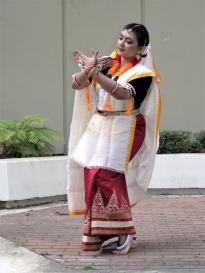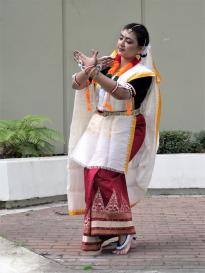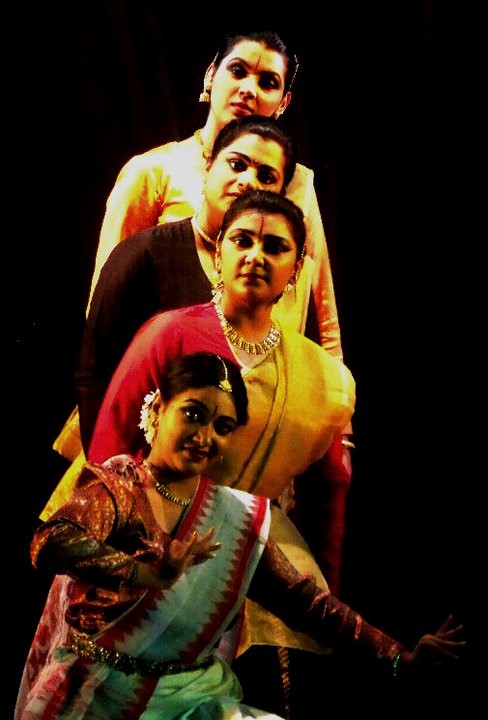Contribute
| Lokvani Talks To Krishnakali Das Gupta, Scientist And Dancer |
Nirmala Garimella
11/07/2017
Krishnakali Das Gupta is a Postdoctoral Fellow at the Dept. of Basic Sciences and Craniofacial Biology at NYU. Previously she was a Postdoc jointly at Boston Children’s Hospital and Harvard Med School , Dept. of Genetics for 2 years. Her study is on developmental defects in craniofacial tissues and the genetic causes for them. She did her Undergrad and Masters studies in India at Presidency College, Calcutta and Dept. of Biochemistry, Univ.of Calcutta. Following which she did my Doctoral studies from USC , Los Angeles, in Genetics and Developmental Biology. She will be performing on Saturday at the Trinethra Dance festival. How were you introduced to Manipuri? Where did you learn and your guru? My mom noticed my love for dance at a very young age and enrolled me at Children’s Little Theatre , a pioneering Institute in Kolkata for teaching all aspects of Indian dance ( classical and folk ), music, art, stagecraft, theatre etc for children. So my formal training in dance started there when I was 4 years old. CLT invites eminent classical dancers from the city to train older students in the classical forms and direct Dance-dramas on the old Natyashastra format and so when I was around 10 years old , Smt. Poushali Chatterjee, an award winning Manipuri dancer and shishya of the legendary Guru Bipin Singh joined CLT as a teacher. In her first year she directed the dance-drama ‘Maharshi-Bhagyachandra’ -the story of the King who took up Vaishnavism, established Govindaji’s temple in Imphal and designed the currently famous Ras-leela form -which is known as the Classical form of Manipuri dance -with Krishna -Radha and the Gopis. Poushalidi tested my dancing style and cast me in the character of ‘Sutradhar’ or storyteller in the play. That was my very first foray in Manipuri dance and I took to it like a fish to water, though at that time I was already learning Kathak and Bharatnatyam in CLT and Kathakali from the late Guru Govindan Kutty outside. My association with Manipuri began from that day, and when our batch graduated from CLT ( when we were about 14 years of age), Poushalidi as we lovingly call her started her Institute -Nandanik Manipuri Dance Academy with us as the inaugural batch. For the following decade we trained and performed extensively with her, as Nandanik’s professional troupe. She was and still is a superlative teacher and choreographer who turned young teenagers into professionals in one of the most difficult and nuanced classical forms with relentless energy and great focus on details. She taught us technical pieces of the tandava, lasya and cholom styles and bhangis, taal , bol and theory, mridang playing, costume detailing as well as choreography of modern pieces. Besides Manipuri Nartanalaya, Poushali Chatterjee till date has the largest number of successful classically trained students Manipuri who are invited by all senior dancers in India to perform with them. She also helped us take special training from Guru Kalavati Devi and Guru Darshana Jhaveri and the Manipuri martial art form- Thang-ta from Ojha Ranjeet Chingtham. In 2006, I decided to join USC for my doctoral studies and that time my then Gurus , Poushalidi and Smt. Darshana Jhaveri , directed me towards Dr.Sohini Roy a senior shishya of Guru Bipin Singh and a renowned exponent of Manipuri herself, who luckily for me lived in Los Angeles. For the next eight years I trained and worked with her while I pursued my graduate studies and have received unsurmountable amount of guidance, support and love from her. There is a unique art that you learnt from your guru that is for men only in India. Can you elaborate? Guru Bipin Singh pioneered several aspects of the stage presentation format of classical Manipuri to bring it to a greater audience. One of them is teaching his female students to play the Pung or manipuri Mridang. In Manipur all musical instruments have great ritualistic value and the Pung is played by men only -in the dance known as Pung-Cholom. But Guruji broke this tradition and his female students have established the tradition of playing the Pung live on stage in an item called Mridang -Vadan. I plan to present this at the Trinethra festival festival. What can we expect to see at the Trinethra dance festival? Dance and music performances in Manipur are parts of elaborate festivals and rituals and as such are night-long to week long performances , very much like Sankirtan of the Vaishnavite style. The dances are also very typical to each festival or ritual. Thus in order present it in a time bound manner to a stage audience is a great challenge. So we do not have a fixed repertoire order, rather were taught to showcase the variety of the rich traditional heritage in the best possible compilation for each show. Also one has to keep in mind Manipuri is designed for group performances , whereas here I am doing solo. So for the festival this time, I am planning to present some pure technical and abhinaya pieces from the Rasleela as well the very old pre-Vaishnavite choreographies of the Mridang -Vadan ( playing the Pung) and Maibi-Jagoi- the ritualistic dance of the priestesses. What are your other interest and hobbies? I have always been deeply involved in artistic and creative extra curricular activities. So I like to be involved in theatre since in school. I was an deeply involved in Vidushak, USC -the only all Indian Improv Theatre group in the US, during my stay at USC. We did live Improv performances every fortnight , wrote and performed plays once per year and also made a series of Short Films. This led to my interest in film-making and I have made 2 independent Short films till date , one of which was for a Harvard Script Writers competition -which got selected for screening. On the other hand my father taught me English and Bengali recitation for which I have actually won competitions and worked with Nehru Childrens Museum as an MC for their cultural programs. Voice-artistry is one my most favourite activities. Earlier I used to live presentations but with the technology at hand work in my spare time to record my favourite poems and upload them on Soundcloud . Recently I started working on some of the well known children’s books in bengali - to make audiobooks from them. Though I do all of these for fun, I love reading books and watching films. I naturally love to watch all kinds of live stage performances. I also love learning languages and scripts. Last but not the least I love to travel and do photography, write about my experiences and though I am not a great cook ,I am a great foodie and love to try out all kinds of cuisines. Best to say I love experiencing and enjoying life from every aspect possible. Since you are at the intersection of the Sciences and the Arts what has been your experience in balancing these interests? It has been a very interesting journey. When I was young it came very naturally because of my parents. My family is full of doctors and engineers , but an artistic temperament was always given great importance. My father, uncles and Grand uncles -who are doctors , engineers or mathematicians pursued drawing , sketching and painting throughout their lives. My mother and several of my cousins are also heavily into skteching and painting. So it was the same person who taught me alphabets and math as well as holding a painting brush. My mother taught me music first as well as helped me do my homework. My parents who may have seemed quite unconventional at that time taught me to take both my education and my artistic pursuits seriously, supporting me in all aspects all the way. They would even regularly encourage me to look for more interesting avenues to explore. My father on one hand bought me ‘physics experiment kit’ and helped me run those tests discussing what I had learnt as a theory while he actually used my mother’s sewing machine to handstitch my ghungroo , because my old one was falling apart. With them I learnt it was not necessary to see science and arts separately. It became difficult later, when I decided to pursue Biological sciences and build a career out of it. To most people in the field of science , the arts are hobbies. I understood at that point why a lot of others give up their passion at that point. So technically I have been a big rebel in the field of pure scientific academia by sticking to the idea that I have a serious commitment to another field beyond science, beyond research. Also in the professional dancing world, people can be skeptical of how serious you are about your art if you are following a traditional full time career already. That is where I learnt to keep these 2 aspects separate. I focus on the language and attitude of science when at work which is very technical and logical and on the language of the arts which is more fluid and introspective when I am working as a dancer. The key is to be in the ‘world’ of the people you are working with at any given point of time. Like flipping between 2 languages. This I have worked out by years of practise. But I realised that to be able to do that one has to truly love both intensely. One has to have true enthusiasm for something to be able to do it successfully. One has to be ‘excited’ about it. I have never doubted whether or not I wanted to do both and I know I cannot give up either. So I prioritise and finish the list of things to complete. For both. What is one aspect that is common for both? The one aspect that is common to both my chosen fields, biological sciences and dance is the importance of observation. So I constantly work on my power of clearer observation which helps in both my careers. Truthfully speaking I am not as aggressive about my dance career as I am about my scientific career, because I feel my dance is more intimately involved with my personal growth and I think and follow my heart to slowly take it to the places where my heart wants to go and like to build it one step at a time. One has to relax ones mind completely to let the creative movements arise. I also wish people in the scientific field were a little more open to artistic pursuits as a legitimate activity. On the contrary I received a lot of support from my dance Gurus in this aspect, because both Poushalidi and Sohinidi are accomplished academicians. Both were toppers from their University and while Poushalidi has been a professional supporting her family all her life ( even as we were her students), Sohinidi completed her PhD in Meitei Revivalism and Meitei script and recently completed her law degree. She also completed her Postdoctoral Fellowships from Harvard and Cambridge University.They encouraged us to carry our study materials when on tours and allotted practise as well study hours. They never allowed us to focus on dance while neglecting our education. If there is anything that might be of interest to the reader? As I was saying, while my friends at Vidushak were of great help to balance out the scientific versus artistic aspect of my life at University, my journey in Dance is incomplete without mentioning 2 names , Debanjana Roy and Debanjali Biswas, my 2 Guru-bhagnis, part of that inaugural group of Nandanik who have been my dance mates since we joined CLT as 4 year olds. In 2006 we decided to cement our long-standing friendship and journey of dance by forming Mitradheya- our own group to keep the tradition of Manipuri dance alive in our own way. We perform the traditional repertoire as well as produce original pieces on contemporary or global themes and present them to the world audience, in collaboration with junior students of Nandanik. Last year we successfully celebrated our 10 year anniversary with several performances in the UK , concluding with a packed house performance at the Nehru Centre, Indian Embassy, London. Truly the 3 of us were meant to dance together and hope to produce many more productions over the years. -------------------------------------------------------------------- http://www.lokvani.com/lokvani/cal.php?stage=1&event_id=13514 Website - http://aroekta.wix.com/mitradheya Photos of our productions : https://mitradheya.smugmug.com/
You may also access this article through our web-site http://www.lokvani.com/


